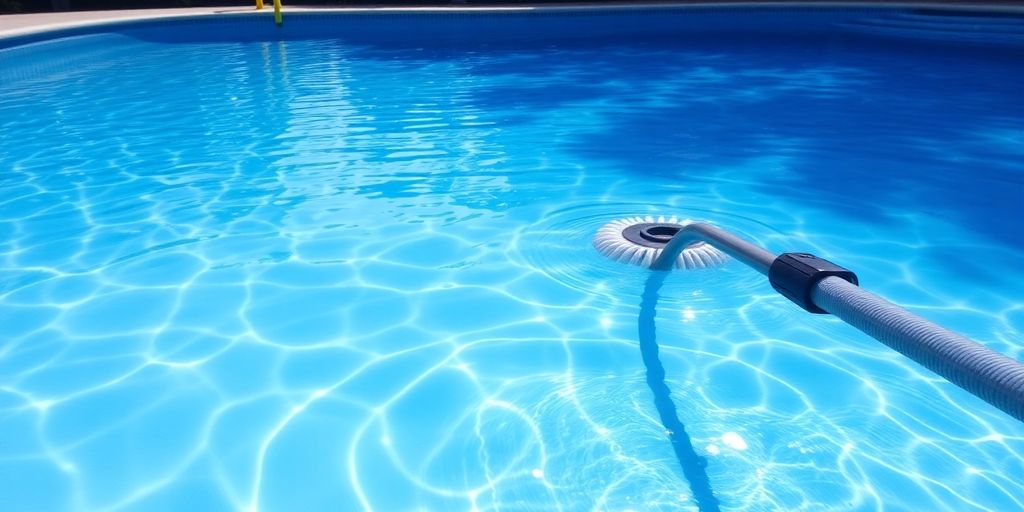Keeping your pool clean is essential for enjoying those hot summer days. A well-maintained pool not only looks great but also provides a safe swimming environment for your family. Vacuuming the pool can seem a bit daunting, but with the right approach and tools, it can be quite straightforward. This guide will walk you through the essential steps and tips to achieve a sparkling clean finish when vacuuming your pool.
Key Takeaways
- Select the right vacuum head for your pool type.
- Clear the surface debris before vacuuming to avoid clogging.
- Use a systematic cleaning pattern to ensure thorough cleaning.
- Check for suction issues regularly to maintain efficiency.
- Incorporate regular maintenance like backwashing to keep your pool in top shape.
Essential Tools For Vacuuming Pool Maintenance
Choosing The Right Vacuum Head
Picking the right vacuum head is super important. Different pool surfaces need different heads to avoid damage and get the best clean. For example, if you’ve got a fibreglass pool, you’ll want a head with soft bristles to avoid scratching. Concrete pools can handle something a bit tougher. It’s worth spending a bit of time to find the right one; it’ll save you headaches down the line.
Understanding Pool Hose Types
Not all pool hoses are created equal. You’ve got your standard hoses, but also heavier-duty ones that are less likely to kink or collapse. Kinks can really mess with your suction, so a good quality hose is a solid investment. Think about the length too – you want something long enough to reach every corner of your pool without having to move the pump all the time. It’s a small thing, but it makes a big difference. Understanding your swimming pool plumbing diagram can also help you choose the right hose length and diameter for optimal performance.
Importance Of A Telescopic Pole
A good telescopic pole is like the unsung hero of pool cleaning. You want something sturdy that won’t bend or break when you’re reaching for those far corners. Make sure it’s adjustable so you can get the right length for different parts of the pool. Trust me, a flimsy pole will make vacuuming a real pain. Get a decent one, and your back will thank you.
A telescopic pole is not just about reach; it’s about control and comfort. A well-built pole allows for precise movements, ensuring you don’t miss any spots and reducing strain on your body. It’s a small investment that pays off in the long run, making pool maintenance less of a chore.
Preparing Your Pool For Vacuuming
Before you even think about dragging that vacuum hose out, a bit of prep work can save you a heap of time and hassle. Trust me, a little effort upfront makes the whole vacuuming process way smoother. Let’s get into it.
Clearing Debris From The Surface
First things first, grab your trusty skimmer net and get rid of any leaves, twigs, or other floating bits and pieces. This stops your vacuum from getting clogged up and makes the whole process more efficient. You don’t want to be pushing a mountain of leaves around the pool floor, do you? A quick once-over with the net will do the trick. If you’ve got a lot of larger debris, a pole rake can be a lifesaver.
Adjusting The Pool Philtre Valve
Now, this is where things get a little technical, but don’t stress, it’s pretty straightforward. You’ll need to adjust your pool philtre valve depending on how dirty your pool is. If it’s just a bit dusty, set the valve to "philtre". This will clean the water as you vacuum. But if your pool is looking like a swamp, with heaps of muck and large debris, switch the valve to "waste".
Setting the valve to "waste" means the dirty water will bypass the philtre and go straight out the backwash line. This is great for getting rid of really gross stuff, but it also means you’ll lose water. So, keep an eye on the water level and have a hose handy to top it up if needed.
Setting Up The Vacuum
Alright, time to get the vacuum ready. First, make sure your pool hoover or vacuum is properly assembled. Check that the vacuum head is securely attached to the telescopic pole and that the hose is connected properly. Now, lower the vacuum head into the pool, making sure it can reach the deepest part. With the philtre and pump running, hold the end of the vacuum hose near a return jet. This will force water through the hose, getting rid of any air inside. You’ll see bubbles coming from the vacuum head – that’s a good sign! Once the bubbles stop, you’re good to go. Keep the hose submerged while you attach it to the skimmer. You can find the skimmer directly above the suction vent.
Effective Techniques For Vacuuming Pool
Mastering Cleaning Patterns
Okay, so you’ve got your vacuum all set up, now what? Don’t just go willy-nilly around the pool! Having a good cleaning pattern is key to making sure you get every bit of gunk off the bottom. I usually start at the shallow end and work my way to the deep end, doing overlapping lines. Think of it like mowing the lawn – you want to make sure you’re not missing any spots. Then, I hit the walls, steps, and corners. Those spots can be tricky, so I use a mix of up-and-down and side-to-side motions to get everything.
Maintaining Proper Suction Power
Getting the right suction is super important. Too little, and you’re just pushing the dirt around. Too much, and the vacuum gets stuck to the bottom. It’s a bit of a balancing act. Make sure your philtre is clean, because a clogged philtre will kill your suction. Also, check all the connections to make sure there aren’t any air leaks. Sometimes, I’ll adjust the valve settings to get the suction just right. You’ll know you’ve got it right when the vacuum is picking up debris without getting stuck.
Managing Your Vacuum Hose
Ugh, the vacuum hose. It can be a real pain, right? First off, make sure it’s full of water before you start vacuuming. That gets rid of the air and helps with suction. Also, try to keep it as straight as possible. Kinks and twists will mess with the water flow. I like to use a lightweight hose because it’s easier to move around the pool. And when you’re done, make sure to drain all the water out of the hose before you store it. That’ll help it last longer.
Vacuuming the pool doesn’t have to be a chore. With a bit of practise and the right techniques, you can get your pool sparkling clean in no time. Just remember to take your time, be patient, and don’t be afraid to experiment to find what works best for you.
Common Challenges When Vacuuming Pool

Vacuuming the pool, while seemingly straightforward, can throw up a few curly ones. Let’s look at some common issues and how to tackle them.
Loss Of Suction Issues
One of the most frustrating problems is losing suction while you’re vacuuming. There are a few reasons why this might happen. The most common culprit is a blockage somewhere in the system. Check the skimmer basket and the pump basket first – they often get clogged with leaves and debris. Also, inspect your vacuum hose for any kinks or leaks. Even a small hole can let air in and reduce suction. If your pool philtre is too dirty, it can also restrict water flow, so give it a clean or backwash.
Dealing With Clogged Philtres
Clogged philtres are a pain, but they’re easily managed with a bit of know-how. Here’s a quick rundown:
- Regular Backwashing: This is your first line of defence. Backwash your philtre regularly, especially after a heavy vacuuming session.
- Philtre Cleaning: Give your philtre a proper clean every few months. You can use a philtre cleaner solution to remove stubborn dirt and grime.
- Check the Pressure: Keep an eye on the philtre pressure gauge. A sudden increase in pressure usually means it’s time for a clean.
It’s easy to forget about the philtre, but a clean philtre means better suction and a cleaner pool. Make it part of your regular pool maintenance routine.
Handling Large Debris
Sometimes, you’ll come across larger items in your pool that your vacuum struggles with. Here’s how to handle them:
- Pre-Skimming: Before you even think about vacuuming, use a pool skimmer net to remove any large leaves, twigs, or other debris floating on the surface or sitting on the bottom.
- Manual Removal: For really big items, like a brick or a large branch, it’s often easier to just grab them by hand or with a net.
- Slow and Steady: When vacuuming around large debris, go slowly and carefully to avoid clogging the vacuum head or hose. You might need to lift the head slightly to allow the debris to pass through.
Post-Vacuuming Care For Your Pool

So, you’ve just finished vacuuming your pool – great job! But the work doesn’t stop there. Proper post-vacuuming care is just as important to keep your pool sparkling and healthy. Let’s dive into what you need to do after you’ve run that pool vacuum.
Backwashing The Philtre
Backwashing is a crucial step after vacuuming, especially if you’ve picked up a lot of debris. Backwashing cleans the philtre by reversing the water flow, flushing out all the trapped dirt and grime. This helps maintain the efficiency of your philtre and keeps your pool water crystal clear. Here’s a quick guide:
- Turn off the pool pump.
- Set the philtre valve to the ‘Backwash’ position.
- Turn the pump back on and let it run for about 2-3 minutes, or until the water in the sight glass runs clear.
- Turn off the pump again and set the valve to the ‘Rinse’ position. Run for about 30 seconds to settle the philtre bed.
- Finally, turn off the pump and return the valve to the ‘Philtre’ position. You’re good to go!
Restoring Water Levels
Backwashing can lower your pool’s water level, so it’s important to top it up afterwards. Use a garden hose to refill the pool until it reaches the normal level, usually around the middle of the skimmer opening. Keeping the water level right helps your skimmer work properly and keeps your pool cleaning system efficient.
Regular Maintenance Tips
To keep your pool in tip-top shape, here are a few regular maintenance tips to follow:
- Skim Regularly: Use a leaf skimmer to remove any floating debris daily. This prevents it from sinking and needing to be vacuumed.
- Check Chemical Levels: Test and adjust your pool’s chemical levels (pH, chlorine, alkalinity) at least once a week. Balanced water chemistry is vital for preventing algae growth and keeping the water safe for swimming.
- Inspect Equipment: Regularly check your pump, philtre, and other equipment for any signs of wear and tear. Addressing small issues early can prevent bigger, more costly problems down the track.
Regular maintenance is key to a healthy pool. By following these simple steps, you can keep your pool sparkling clean and enjoyable all season long. Don’t skip these steps – they make a big difference!
Enhancing Your Pool Cleaning Routine
Frequency Of Vacuuming
How often should you vacuum your pool? Well, it really depends. If your pool gets a lot of use, aiming for at least once a week is a good rule of thumb. Otherwise, you might start seeing a build-up of debris at the bottom after a few weeks. Think about it – more swimmers mean more sunscreen, leaves, and general muck ending up in the water. For pools that aren’t used as often, you might get away with vacuuming every other week. Keep an eye on the pool floor and adjust your schedule accordingly. It’s all about finding what works best for your specific situation.
Incorporating Pool Shocking
"Shocking" the pool is a super important step to keep the water crystal clear and hygienic. Basically, you’re adding a heap of chemicals to get rid of any nasties hanging around. Ideally, you should be shocking your pool at least once a week. Chlorine-based shocks are great for killing bacteria, but there are other types that can oxidise the water and remove algae and other contaminants. It’s a good idea to shock the pool after heavy use or after a storm, just to make sure everything’s squeaky clean. Regular shocking helps maintain water quality and keeps your pool safe for swimming.
Using Additional Cleaning Tools
Beyond the vacuum, there are a few other tools that can really help keep your pool in top shape. A good pool skimmer is essential for scooping up leaves and debris from the surface before they sink to the bottom. Brushes are great for scrubbing the walls and floor to loosen any algae or dirt. You can get brushes with different bristle types depending on your pool surface – softer bristles for fibreglass, tougher ones for concrete. And don’t forget about automatic pool cleaners! These little guys can roam around the pool and vacuum up debris without you having to lift a finger. They can be a bit pricey, but they’re a great investment if you want to save time and effort.
Keeping on top of your pool cleaning routine doesn’t have to be a massive chore. By vacuuming regularly, shocking the water, and using the right tools, you can keep your pool sparkling clean and ready for a dip whenever you fancy it. A little bit of effort goes a long way in maintaining a healthy and enjoyable swimming environment.
Troubleshooting Vacuuming Problems
Identifying Common Issues
Alright, so you’re vacuuming the pool and things aren’t going smoothly? Don’t stress, it happens. Let’s look at some common culprits. One of the first things to check is whether you’ve got enough suction. Is the vacuum head just sitting there, or is it actually picking stuff up? Another issue could be air in the hose – those pesky bubbles can really mess things up. Also, have a look at your philtre; a dirty pool philtre can seriously reduce the vacuum’s effectiveness.
Solutions For Persistent Problems
Okay, so you’ve identified the problem, now what? Here’s a few things you can try:
- Check for leaks: Inspect the vacuum hose for any cracks or holes. Even a small leak can cause a big loss of suction. If you find one, grab some duct tape or replace the hose altogether.
- Prime the hose properly: Make sure you get all the air out of the hose before you start vacuuming. Hold the hose near a return jet until the bubbles stop. This is super important!
- Clean the philtre: Give your philtre a good backwash. A clean philtre makes a world of difference. If it’s really dirty, you might even need to give it a chemical clean.
Sometimes, the issue isn’t the vacuum itself, but the pool’s overall condition. Make sure your pool chemistry is balanced. High levels of algae or other contaminants can clog the philtre quickly and reduce suction.
When To Call A Professional
Sometimes, you just can’t fix it yourself, and that’s okay. If you’ve tried everything and your pool vacuum still isn’t working, it might be time to call in the pros. Here are some signs it’s time to get help:
- The pump is making weird noises.
- You’ve got a persistent leak that you can’t find.
- The vacuum is brand new and never worked properly.
\nLook, pool maintenance can be a pain, but a clean pool is worth it. Don’t be afraid to ask for help if you need it. A pool hoover or vacuum is a great tool, but sometimes you need a professional touch.
Final Thoughts on Pool Vacuuming
So there you have it! Vacuuming your pool doesn’t have to be a chore. With a bit of practise and the right tools, you can keep your pool looking great all summer long. Just remember to take your time, follow a good pattern, and don’t rush it. If you run into any hiccups, like losing suction or dealing with a messy philtre, don’t sweat it—everyone faces those issues at some point. Just keep at it, and soon enough, you’ll be a pro at this. A clean pool means more fun for you and your mates, so get out there and enjoy that sparkling water!
Frequently Asked Questions
How often should I vacuum my pool?
If you use your pool regularly, it’s best to vacuum it at least once a week to keep it clean.
What should I do if my vacuum loses suction?
If your vacuum loses suction, check for kinks in the hose or clean the philtre. You may need to reconnect the hose to the return jet to remove any air.
Can I vacuum my pool without a skimmer net?
Yes, if you don’t have a skimmer net, you can use a pole rake to remove larger leaves and debris before vacuuming.
What is the best way to remove large debris from the pool?
For large debris, it’s best to use a net or a rake first before vacuuming to make the process easier.
Is it necessary to shock the pool after vacuuming?
Yes, shocking the pool after vacuuming can help keep the water clean by killing any bacteria and algae.
When should I call a professional for pool cleaning?
If you face persistent issues or if the pool is extremely dirty, it’s a good idea to call a professional for help.





